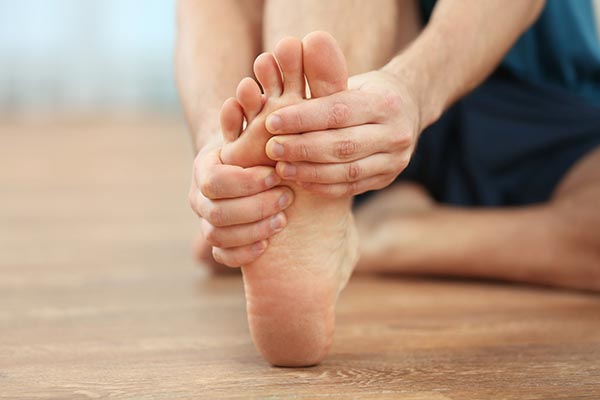It is not surprising that our feet can develop painful conditions. The average person walks 8,000-10,000 steps a day, which equates to walking four times around the world over the course of a lifetime. This can cause wear and tear in the 26 bones and 8000 nerves in our feet.
Women are more prone to certain types of foot problems, mainly due to choice of footwear, with narrow-fitting shoes tending to squeeze the toes and high heels potentially leading to arch and ankle problems. Among the conditions that can benefit from podiatry are problems on the surface of the feet and nails (such as ingrowing toenails, calluses and corns and verruca) and more structural problems (such as bunions, flat feet, high arches and heel pain). Podiatrists also treat sports-related injuries.

What is podiatry?
Podiatry is the diagnosis and treatment of conditions affecting the feet, ankles and lower limbs. A podiatrist may treat acute or chronic (long-term) conditions. Depending on the condition, they may recommend conservative care or a corrective approach that could include surgery. Podiatry plays a key role in the management of long-term health conditions that can affect the feet, such as diabetes. This is because one of the complications of diabetes is poor circulation and foot numbness which can cause serious skin ulcers that sometimes lead to limb amputations.
Private podiatry at Harley Street Specialist Hospital
Harley Street Specialist Hospital is a leading team of leading podiatrists, offering the very latest approaches to diagnosis, treatment and prevention of foot and ankle problems, from minor issues to the most debilitating.
Our specialist podiatrists specialise in the treatment of:
Bunions
This is the development of a bony growth below the base of the big toe. Non-surgical treatment includes protective cushioning, toe spacers/night splints, or orthotics. If conservative measures fail, surgery may be necessary. There are four main types of bunion surgery – your podiatrist will discuss the best one for you.
Drop foot
This is when it is difficult to lift the front of the foot which can cause the foot to drag along the floor or flop to the side. It is normally treated with a tendon transfer to replace damaged sections of tendon that support the foot.
Flat foot
The foot is naturally arched but if the arch is collapsed the condition is referred to as flat feet. Treatment is not always necessary but if the condition causes pain there are different surgical options available, including a minimally invasive procedure called HyProCure.
Hallux rigidus – stiff big toes
This is a form of arthritis that affects the joint at the base of the big toe, causing pain and stiffness. If non-surgical measures fail to provide relief you may be offered a cheilectomy to remove excess bone caused by arthritis, joint fusion or joint implant surgery.
Hammer toe – claw toe – mallet toe
These are all conditions that cause the toes to become fixed in a bent position, causing pain and discomfort. It is due to muscles becoming weak, causing the tendons to pull the toe out of shape. Non-surgical treatment includes orthotics and splints but surgery such as arthroplasty may be needed to correct toe alignment.
Heel pain
There can be a number of causes including nerve impingement, tight calves, heel bursitis or plantar fasciitis. Non-invasive treatment includes shockwave therapy to promote healing, physiotherapy or orthotics to cushion the heels. It is rare for heel pain to need plantar fascia release surgery – only around 1% of cases.
Ingrown toenail
This is when the sides of the nail cut into the surrounding skin causing pain, swelling and sometimes infection. If the problem is persistent or if you develop a fungal nail, you may need a partial or full nail avulsion (removal of the affected nail) or complete excision of the nail bed.
Morton’s neuroma
This is a damaged or irritated nerve – normally between the 3rd and 4th toes, but less commonly between the 2nd and 3rd. It produces a sharp radiating pain or numbness. If conservative measures fail you may need surgery to remove part of the damaged nerve.
Plantar plate injury
The plantar plates are thickened ligaments on the balls of the feet. If they become torn or damaged due to microtears that develop over time or a sudden acute injury, the stability of the toes can be affected. You may require strapping to keep the toe aligned, immobilisation or surgical repair.
Short toe surgery
Also called brachymetarsia, short toe is a foot deformity that most commonly occurs in the 4th toe. It may be treated with orthotics to redistribute the weight or surgery to lengthen the toe. The podiatrist will discuss the best options for your particular condition.
Why choose Harley Street Specialist Hospital?
At Harley Street Specialist Hospital, you can expect:
- Our team of expert podiatrists to offer rapid assessment and the latest treatments in comfortable central London surroundings, as well as video consultations from the comfort of your own home.
- Holistic care where you are an equal partner in the creation of your individualised treatment plan.
- State of the art diagnostic imaging – you don’t need to go elsewhere as we have in house X-ray, ultrasound and image intensifiers.
- Day-case and outpatient investigations and surgical procedures in a modern clinical setting.
- No waiting lists and your treatment can take place at a convenient time for you.
We welcome patients with private medical insurance or those wishing to pay for their own treatment.



